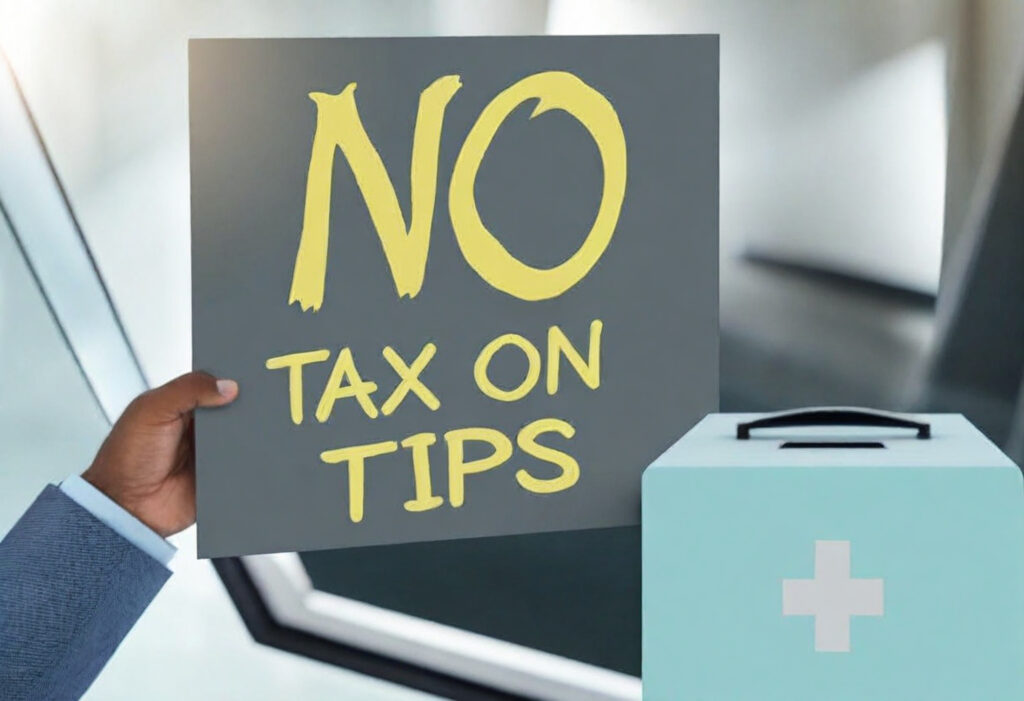 The deduction for no-tax-on-tips, or more simply tips deduction, was created by the One Big Beautiful Bill Act of 2025 (OBBBA). Even though OBBBA was signed into law on July 4, 2025, the tips deduction is effective as of January 1, 2025. About 4 million people in the U.S. work in tipped occupations, but it’s estimated that only about 2.5% of them will be able to take the deduction. Why? There are a number of qualifications for the deduction. Small business owners should familiarize themselves with the rules to field employee questions and to know how to handle W-2 reporting.
The deduction for no-tax-on-tips, or more simply tips deduction, was created by the One Big Beautiful Bill Act of 2025 (OBBBA). Even though OBBBA was signed into law on July 4, 2025, the tips deduction is effective as of January 1, 2025. About 4 million people in the U.S. work in tipped occupations, but it’s estimated that only about 2.5% of them will be able to take the deduction. Why? There are a number of qualifications for the deduction. Small business owners should familiarize themselves with the rules to field employee questions and to know how to handle W-2 reporting.
Rules to know:
1. Personal deduction capped at $25,000
The tips deduction belongs to the person who earns the tips. It is not a deduction for an employer.
The maximum deduction is $25,000—the same limit for singles as well as joint filers. The dollar limit is per return, not per taxpayer, so if both spouses receive qualified tips, they can only write off $25,000 of a joint return. But it only applies if modified adjusted gross income (MAGI) is below a set amount:
- Singles: Full deduction for MAGI up to $150,000; phase-out up to $400,000. No deduction may be taken if MAGI is $400,000 or more.
- Joint filers: Full deduction for MAGI up to $300,000; phase-out up to $550,000. No deduction may be taken if MAGI is $550,000 or more.
The deduction can be claimed by eligible workers whether they claim the standard deduction or itemized deductions.
2. Not an AGI deduction
Unlike deductions for contributions to IRAs and HSAs, as well as many other “above-the-line” deductions, the tips deduction does not reduce adjusted gross income (AGI). It does not impact eligibility for various deductions and credits that are based on AGI (or modified AGI).
3. Tips must be reported to the IRS
Only tips reported to the IRS are eligible for the deduction. Those who accepts tips in cash and don’t report them can’t use the deduction. It’s estimated that only about 4% of tipped individuals report the tips to the IRS.
- For employees: Tips must be reported on Form W-4 or Form 4137.
- For self-employed individuals: Tips must be reported on Form 1099-NEC. Tips may be reported on Form 1099-K for payments made through a credit card processor, PayPal, Venmo, and certain other payment platforms, but the reporting threshold for this form is high (more than $20,000 and more than 200 transactions in the year), so it’s unlikely to be used.
4. Tips must be earned in IRS-approved industries
Only tips earned in IRS-approved industries can qualify for the deduction. Proposed regulations released late in September list nearly 70 occupations that fall into 8 categories:
- Beverage and food service (e.g., bartenders, waitstaff, fast food and counter workers, bakers)
- Entertainment and events (e.g., gambling dealers, dancers, digital content creators, locker room/coat room attendants)
- Hospitality and guest services (e.g., baggage porters/bellhops, maids and housecleaning services)
- Home services (e.g., home maintenance/repair workers, landscape and grounds keepers, home electricians, home plumbers, locksmiths)
- Personal services (e.g., private event planners, pet caretakers, tutors)
- Personal appearances and wellness (e.g., massage therapists, exercise trainers, tattoo artists, tailors)
- Recreation and instruction (e.g., golf caddies, tour guides)
- Transportation and delivery (e.g., parking attendants, goods delivery people, home movers)
Tips received in illegal activities (e.g., prostitution; pornographic activities) are not qualified tips.
5. Tips must be paid in cash
The term “cash” for this purpose include an equivalent medium, including checks, credit cards, debit cards, gift cards, tangible or intangible tokens that are readily exchangeable into a fixed amount of cash (e.g., a casino chip), or an electronic/mobile payment (e.g., Apple Pay).
6. Tips must be paid voluntarily
Only tips received from customers that are voluntary can be deductible. Service charges and automatic gratuities (e.g., 18% imposed by a restaurant for a large party that is distributed to bussers and kitchen staff in addition to waiters) are not treated as qualified tips; customers have no option to reject it. But amounts above the mandatory gratuity can be qualified tips.
Tips can also be qualified if they are a mandatory or voluntary tip-sharing arrangement (e.g., tip pool).
7. Self-employed individuals may be able to take the deduction
The tips deduction is primarily for employees, but some self-employed individuals may also qualify.
- They must work in an eligible occupation.
- They can’t work in a specified service trade or business (SSTB), such as the fields of law, health, accounting, and athletics.
- They must have tips reported to the IRS (explained earlier).
Qualifying tips earned by self-employed individuals are subject to self-employment tax.
8. Claiming deduction
The deduction is claimed a new form–Schedule 1-A. The amount is then entered directly on Form 1040 or 1040-ES, which is a subtraction from adjusted gross income.
9. Adjusting income tax withholding
Employees who expect to qualify for the deduction may want to adjust their income tax withholding. This can be done for the remainder of 2025 by submitting a new Form W-4 with the employer. Use the Step 4(b)—Deductions Worksheet to take the tips deduction into account.
Employees who want to adjust their income tax withholding for 2026 can use the same worksheet in the draft of Form W-4 for 2026 to take into account the deduction for qualified tips. The IRS Tax Withholding Estimator (TWE) has not yet been updated for this purpose.
10. Employer reporting on Form W-2
Tips have traditionally been reported on Form W-2, but for 2025, there is no special box for reporting qualifying tips.
For 2026 (that will be filed in 2027), Form W-2 is revised.
- Box 12 will use a new code—TP—to report qualified tips.
- Box 14b is a new box to report the tipped occupation code.
Final thought
An old NPR article discussed when tipping was considered deeply un-American. Mark Twain and Ralph Waldo Emerson raged against the gratuity system. Not so today. Tips—whether and how much—remain controversial, but a usual practice. Now it’s time to factor in the tax impact of tips.
For additional information on deductions, see this list of blogs.


